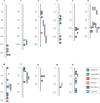New insights into the genetics of addiction
- PMID: 19238175
- PMCID: PMC2879628
- DOI: 10.1038/nrg2536
New insights into the genetics of addiction
Abstract
Drug addiction is a common brain disorder that is extremely costly to the individual and to society. Genetics contributes significantly to vulnerability to this disorder, but identification of susceptibility genes has been slow. Recent genome-wide linkage and association studies have implicated several regions and genes in addiction to various substances, including alcohol and, more recently, tobacco. Current efforts aim not only to replicate these findings in independent samples but also to determine the functional mechanisms of these genes and variants.
Figures


References
-
- Kreek MJ, Nielsen DA, Butelman ER, LaForge KS. Genetic influences on impulsivity, risk taking, stress responsivity and vulnerability to drug abuse and addiction. Nat Neurosci. 2005;8:1450–1457. - PubMed
-
- Edenberg HJ, Foroud T. The genetics of alcoholism: identifying specific genes through family studies. Addict Biol. 2006;11:386–396. - PubMed
-
- Goldman D, Oroszi G, Ducci F. The genetics of addictions: uncovering the genes. Nat Rev Genet. 2005;6:521–532. - PubMed
-
- Li MD, Cheng R, Ma JZ, Swan GE. A meta-analysis of estimated genetic and environmental effects on smoking behavior in male and female adult twins. Addiction. 2003;98:23–31. - PubMed
-
- Uhl GR, Liu QR, Naiman D. Substance abuse vulnerability loci: converging genome scanning data. Trends Genet. 2002;18:420–425. - PubMed

